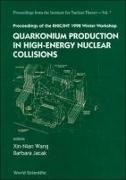Read more
Charmonium suppression is a promising signal of quark-gluon plasma. In this volume, the latest development both in experiments and in the theory of charmonium production in high-energy nucleus-nucleus collisions are presented and discussed. This invaluable book is based on E Witten's lectures on topological quantum field theory which were presented in the spring of 1989 at Fine Hall, Princeton. At that time Witten unified several important mathematical works in terms of quantum field theory, most notably the Donaldson polynomial, Gromov/Floer homology and Jones polynomials.In the book Witten explains his three-dimensional construction of Jones polynomials via Chern-Simons gauge theory. The classical moduli space consists of unitary flat connections. To quantize it, he constructs a Hilbert space consisting of holomorphic sections of the natural determinant bundle over the moduli space, or non-Abelian theta functions. He explains that the quantization is independent of complex structures so that the theory becomes topological. He then constructs morphisms in terms of the Feynman path integral. He provides the relevant background, such as the Feynman -- Kac formula and Feynman diagrams, thus making the book more accessible to mathematicians. His construction leads to many beautiful applications, such as the skein relation, the surgery formula and a proof of Verlinde's formula.
List of contents
A brief history of J/y suppression, H. Satz; some thoughts about J/y absorption, B. Muller; colour and spin in quarkonium production, E. Braaten; onset of the anomalous J/y suppresion in Pb collisions, M. Gonin; vector meson production and nuclear effects in FNAL E866, M.J. Leitch; intermediate mass dimuons in NA38/NA50, E. Scomparin; anomalous J/y suppression in lead-free collisions - is there a break in the J/y cross section?, N. Armesto et al; Drell-Yan cross section and J/y production in high energy nucleus-nucleus collisions, C.-Y. Wong; cluster formation and J/y suppression, M. Nardi; the QCD phase transition and J/y suppression, E.V. Shuryak; the possible role of gluon depletion in J/y suppression, R.C. Hwa; nuclear effects on charmonium production, X.-F. Zhang et al; can J/y suppression without partons? C. Gale et al; what is the source of the anomalous J/y suppression? R. Vogt; J/y absorption scenarios in nuclear collisions, J, Geiss et al; quarkonium physics with PHENIX detector at RHIC, Y. Akiba; PHENIX experiment at RHIC, M. Rosati; quarkonium at STAR, T.J. LeCompte; J/y suppression revisited - lessons from ten years of data, C. Lourenco.

